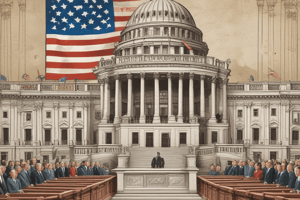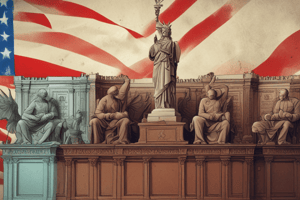Podcast
Questions and Answers
What is primarily ensured by the concept of limited government?
What is primarily ensured by the concept of limited government?
- The dominance of the federal authority over states
- The unchecked power of a single branch
- The protection of individual freedoms through laws (correct)
- The elimination of all government powers
Which principle underscores that political power is derived from the consent of the governed?
Which principle underscores that political power is derived from the consent of the governed?
- Popular Sovereignty (correct)
- Checks and Balances
- Federalism
- Judicial Review
Which system is designed to prevent any one branch of government from becoming too powerful?
Which system is designed to prevent any one branch of government from becoming too powerful?
- Separation of Powers (correct)
- Direct Democracy
- Unitary Government
- Plutocracy
How does federalism affect the distribution of power?
How does federalism affect the distribution of power?
What does judicial review allow courts to do?
What does judicial review allow courts to do?
What is the function of checks and balances in government?
What is the function of checks and balances in government?
What characteristic is NOT a feature of separation of powers?
What characteristic is NOT a feature of separation of powers?
Which of the following concepts emphasizes that government authority must be constrained by laws?
Which of the following concepts emphasizes that government authority must be constrained by laws?
What is the primary function of the Court of Appeals?
What is the primary function of the Court of Appeals?
Which statement accurately describes appellate jurisdiction?
Which statement accurately describes appellate jurisdiction?
Which option correctly identifies a function of the majority opinion in the Supreme Court?
Which option correctly identifies a function of the majority opinion in the Supreme Court?
How many justices currently make up the Supreme Court?
How many justices currently make up the Supreme Court?
What type of cases do federal courts handle?
What type of cases do federal courts handle?
What is a dissenting opinion in the context of the Supreme Court?
What is a dissenting opinion in the context of the Supreme Court?
Which description best characterizes the District Court within the federal system?
Which description best characterizes the District Court within the federal system?
In the context of the current Supreme Court's composition, how many justices are considered conservative-leaning?
In the context of the current Supreme Court's composition, how many justices are considered conservative-leaning?
What was the primary purpose of the Three-Fifths Compromise?
What was the primary purpose of the Three-Fifths Compromise?
Which two plans were combined to form the Connecticut Compromise?
Which two plans were combined to form the Connecticut Compromise?
What major issue did the debates during the Constitutional Convention largely revolve around?
What major issue did the debates during the Constitutional Convention largely revolve around?
What is the main function of the Bill of Rights?
What is the main function of the Bill of Rights?
In the federal system of the United States, what is one key characteristic?
In the federal system of the United States, what is one key characteristic?
What principle does direct democracy embody?
What principle does direct democracy embody?
How long was the importation of slaves permitted to continue after the Constitutional Convention?
How long was the importation of slaves permitted to continue after the Constitutional Convention?
What type of government is characterized by power being held by the individuals?
What type of government is characterized by power being held by the individuals?
What was a key concern of the Antifederalists regarding the Constitution's ratification?
What was a key concern of the Antifederalists regarding the Constitution's ratification?
What does the term 'Electoral College' refer to?
What does the term 'Electoral College' refer to?
Which statement best describes the Federalist Papers?
Which statement best describes the Federalist Papers?
What is the primary purpose of a political party's platform?
What is the primary purpose of a political party's platform?
What change was instituted by the 12th Amendment?
What change was instituted by the 12th Amendment?
Which of the following amendments guarantees voting rights regardless of race, color, or previous condition of servitude?
Which of the following amendments guarantees voting rights regardless of race, color, or previous condition of servitude?
What role do exit polls serve in the electoral process?
What role do exit polls serve in the electoral process?
Which political perspective prioritizes tradition and limited government?
Which political perspective prioritizes tradition and limited government?
What role does the Vice President play in the legislative process?
What role does the Vice President play in the legislative process?
Which amendment established the presidential term limit?
Which amendment established the presidential term limit?
How are the total electoral votes for a state determined?
How are the total electoral votes for a state determined?
Which of the following is NOT a duty of the President as outlined in their constitutional powers?
Which of the following is NOT a duty of the President as outlined in their constitutional powers?
What is primarily conveyed during the State of the Union Address?
What is primarily conveyed during the State of the Union Address?
Which position comes first in the Presidential Succession List after the Vice President?
Which position comes first in the Presidential Succession List after the Vice President?
Which group is involved in advising the President and leading executive departments?
Which group is involved in advising the President and leading executive departments?
What age must a candidate be to qualify for the Presidency?
What age must a candidate be to qualify for the Presidency?
What is the primary purpose of a conference committee in the legislative process?
What is the primary purpose of a conference committee in the legislative process?
Which statement accurately describes the powers of the president regarding a bill?
Which statement accurately describes the powers of the president regarding a bill?
What defines the judicial interpretation method favored by Textualists or Originalists?
What defines the judicial interpretation method favored by Textualists or Originalists?
Which of the following principles is implied by the concerns of the Anti-Federalists?
Which of the following principles is implied by the concerns of the Anti-Federalists?
What is the role of the Supreme Court in the judicial branch?
What is the role of the Supreme Court in the judicial branch?
What distinguishes original jurisdiction from appellate jurisdiction?
What distinguishes original jurisdiction from appellate jurisdiction?
What is the required vote margin for Congress to override a presidential veto?
What is the required vote margin for Congress to override a presidential veto?
What key concept is associated with Living Constitutionalism?
What key concept is associated with Living Constitutionalism?
Flashcards
What is government?
What is government?
The governing body of a nation, state, or community.
What is limited government?
What is limited government?
A political system where the powers of the government are restricted by laws or a constitution to protect individual freedoms. This ensures no branch becomes too powerful, promoting checks and balances.
What is popular sovereignty?
What is popular sovereignty?
The principle that the authority of a government is created and sustained by the consent of its people—who hold the ultimate power. It emphasizes that political power rests with the citizens, typically expressed through voting and participation in democratic processes.
What are checks and balances?
What are checks and balances?
Signup and view all the flashcards
What is federalism?
What is federalism?
Signup and view all the flashcards
What is judicial review?
What is judicial review?
Signup and view all the flashcards
What is separation of powers?
What is separation of powers?
Signup and view all the flashcards
What is the Electoral College?
What is the Electoral College?
Signup and view all the flashcards
Who were the Federalists?
Who were the Federalists?
Signup and view all the flashcards
Who were the Anti-Federalists?
Who were the Anti-Federalists?
Signup and view all the flashcards
What is Federalist Paper #10?
What is Federalist Paper #10?
Signup and view all the flashcards
What is a nomination?
What is a nomination?
Signup and view all the flashcards
What is a General Election?
What is a General Election?
Signup and view all the flashcards
What is the Popular Vote?
What is the Popular Vote?
Signup and view all the flashcards
What are Electoral Votes?
What are Electoral Votes?
Signup and view all the flashcards
What is the Supreme Court?
What is the Supreme Court?
Signup and view all the flashcards
What are Anti-Federalist concerns?
What are Anti-Federalist concerns?
Signup and view all the flashcards
What is a Federal Judge?
What is a Federal Judge?
Signup and view all the flashcards
What are Unofficial Requirements for Federal Judges?
What are Unofficial Requirements for Federal Judges?
Signup and view all the flashcards
What is a Textualist/Originalist judge?
What is a Textualist/Originalist judge?
Signup and view all the flashcards
What is a Living Constitutionalist judge?
What is a Living Constitutionalist judge?
Signup and view all the flashcards
What is Original Jurisdiction?
What is Original Jurisdiction?
Signup and view all the flashcards
What does Article III of the Constitution establish?
What does Article III of the Constitution establish?
Signup and view all the flashcards
What is the District Court?
What is the District Court?
Signup and view all the flashcards
What is Appellate Jurisdiction?
What is Appellate Jurisdiction?
Signup and view all the flashcards
What is a Circuit?
What is a Circuit?
Signup and view all the flashcards
What is the Majority Opinion?
What is the Majority Opinion?
Signup and view all the flashcards
What is a Dissenting Opinion?
What is a Dissenting Opinion?
Signup and view all the flashcards
What are the levels of the Federal Court System?
What are the levels of the Federal Court System?
Signup and view all the flashcards
What types of cases do Federal Courts handle?
What types of cases do Federal Courts handle?
Signup and view all the flashcards
What was the Three-Fifths Compromise?
What was the Three-Fifths Compromise?
Signup and view all the flashcards
What was the Connecticut Compromise?
What was the Connecticut Compromise?
Signup and view all the flashcards
What was the Slavery Debate in the Constitutional Convention?
What was the Slavery Debate in the Constitutional Convention?
Signup and view all the flashcards
What is the Bill of Rights?
What is the Bill of Rights?
Signup and view all the flashcards
Explain the US Federal System.
Explain the US Federal System.
Signup and view all the flashcards
What is Democracy?
What is Democracy?
Signup and view all the flashcards
What is Direct Democracy?
What is Direct Democracy?
Signup and view all the flashcards
What is Representative Democracy?
What is Representative Democracy?
Signup and view all the flashcards
What is a Pardon?
What is a Pardon?
Signup and view all the flashcards
What is a Treaty?
What is a Treaty?
Signup and view all the flashcards
Who is an Ambassador?
Who is an Ambassador?
Signup and view all the flashcards
What is the Cabinet?
What is the Cabinet?
Signup and view all the flashcards
What is the Federal Bureaucracy?
What is the Federal Bureaucracy?
Signup and view all the flashcards
What are Political Appointees?
What are Political Appointees?
Signup and view all the flashcards
What are the Requirements to Become U.S. President?
What are the Requirements to Become U.S. President?
Signup and view all the flashcards
What are the Official Duties of the Vice President?
What are the Official Duties of the Vice President?
Signup and view all the flashcards
Study Notes
No notes provided. Please provide text or questions.
Studying That Suits You
Use AI to generate personalized quizzes and flashcards to suit your learning preferences.




